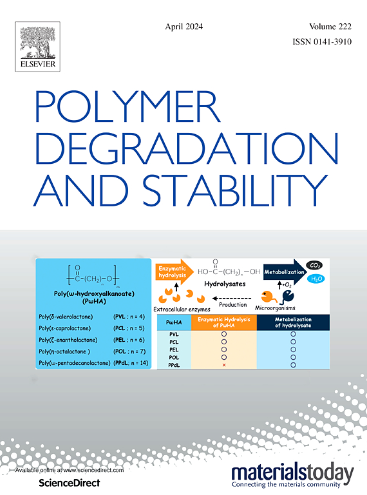以乙二醇为原料,不同乙醇酸摩尔分数生物合成聚乙醇酸-氨基-3-羟基丁酸
IF 7.4
2区 化学
Q1 POLYMER SCIENCE
引用次数: 0
摘要
基于乙醇酸酯(GL)的聚羟基烷酸酯具有高度的可加氢性,在生物医学和其他领域具有潜在的应用前景。本研究在重组大肠杆菌中建立了以工业废弃物中的乙二醇为原料合成无规则共聚物聚(乙醇酸-氨基丁酸-3-羟基丁酸)[P(gl -氨基丁酸- 3hb)]的生物合成途径。重组大肠杆菌在含有EG和木糖的培养基中表达一种能够聚合GL的工程聚羟基烷酸酯(PHA)合成酶(PhaC)、两种提供3HB单体的酶(PhaA和PhaB)和三种提供EG GL单体的酶(FucO、AldA和PCT),产生的GL在P(GL- ran3hb)中的摩尔分数最大为0.24±0.003 mol %。因此,我们将这种方法分为GL-和聚合物合成,这使得在P(GL-ran- 3hb)s中GL的摩尔分数从4.5 mol %增加到49.5 mol %;这表明,从工业废物中提取的EGs具有在各种GL摩尔分数的P(GL-ran- 3hb)合成中使用的潜力。本研究首次报道了GL摩尔分数超过17 mol %的P(GL-ran- 3hb)生物合成。聚合物表征表明,GL单元的加入略微提高了P(GL-ran- 3hb)的玻璃化转变温度,降低了P(GL-ran- 3hb)的熔融温度和分子量。结晶度随GL摩尔分数的增加而降低,特别是对于GL摩尔分数大于46 mol %的聚合物,结晶度几乎是无定形的。我们的发现有助于扩大EG作为PHA新原料的应用范围,并拓宽新型PHA共聚物的应用范围。本文章由计算机程序翻译,如有差异,请以英文原文为准。
Biosynthesis of poly(glycolate-ran-3-hydroxybutyrate)s with different glycolate molar fractions from ethylene glycol
Glycolate (GL)-based polyhydroxyalkanoates have potential for biomedical and other applications owing to their high hydrodegradability. Here, we established a biosynthetic pathway for the synthesis of random copolymer poly(glycolate-ran-3-hydroxybutyrate) [P(GL-ran-3HB)] from ethylene glycol (EG) contained in industrial wastes in recombinant Escherichia coli. Recombinant E. coli expressing an engineered polyhydroxyalkanoate (PHA) synthase (PhaC) capable of polymerizing GL, two enzymes providing 3HB monomer (PhaA and PhaB), and three enzymes providing GL monomer from EG (FucO, AldA, and PCT) in a medium containing EG and xylose, produced a GL molar fraction in P(GL-ran-3HB) of 0.24±0.003 mol % maximum. Therefore, we split this method into GL- and polymer synthesis, which enabled the increase of the GL molar fraction from 4.5 to 49.5 mol % in P(GL-ran-3HB)s by initial concentrations of EG in the medium; this indicates that EGs derived from industrial waste have a potential for use in P(GL-ran-3HB) synthesis with a variety of GL molar fractions. P(GL-ran-3HB) biosynthesis with a GL molar fraction exceeding 17 mol % was reported for the first time in this study. Polymer characterization revealed that incorporation of the GL unit slightly increased glass transition temperature and decreased melting temperature and molecular weight of P(GL-ran-3HB). A decrease in crystallinity with increasing GL molar fraction was observed, particularly for polymers with GL molar fractions above 46 mol %, which were almost amorphous. Our findings contribute to the expanding application of EG as a new feedstock for PHAs and broadening the applications of novel PHA copolymers.
求助全文
通过发布文献求助,成功后即可免费获取论文全文。
去求助
来源期刊

Polymer Degradation and Stability
化学-高分子科学
CiteScore
10.10
自引率
10.20%
发文量
325
审稿时长
23 days
期刊介绍:
Polymer Degradation and Stability deals with the degradation reactions and their control which are a major preoccupation of practitioners of the many and diverse aspects of modern polymer technology.
Deteriorative reactions occur during processing, when polymers are subjected to heat, oxygen and mechanical stress, and during the useful life of the materials when oxygen and sunlight are the most important degradative agencies. In more specialised applications, degradation may be induced by high energy radiation, ozone, atmospheric pollutants, mechanical stress, biological action, hydrolysis and many other influences. The mechanisms of these reactions and stabilisation processes must be understood if the technology and application of polymers are to continue to advance. The reporting of investigations of this kind is therefore a major function of this journal.
However there are also new developments in polymer technology in which degradation processes find positive applications. For example, photodegradable plastics are now available, the recycling of polymeric products will become increasingly important, degradation and combustion studies are involved in the definition of the fire hazards which are associated with polymeric materials and the microelectronics industry is vitally dependent upon polymer degradation in the manufacture of its circuitry. Polymer properties may also be improved by processes like curing and grafting, the chemistry of which can be closely related to that which causes physical deterioration in other circumstances.
 求助内容:
求助内容: 应助结果提醒方式:
应助结果提醒方式:


